Published Nov 22, 2016
Frakes Answers Fans' Questions, Part 2
Frakes Answers Fans' Questions, Part 2

Star Trek: First Contact blasted into theaters on November 22, 1996, wowing Star Trek fans and, much like a tractor beam, attracting even non-Trek fans to the second big-screen adventure of Captain Picard and his Enterprise crew. Jonathan Frakes made his feature directing debut with First Contact, eliciting terrific performances from the Star Trek: The Next Generation regulars, as well as co-stars Alice Krige, Alfre Woodard, James Cromwell and Neal McDonough, and he translated the script’s winsome mix of action, comedy, drama, thrills and pure Trek into a wildly entertaining box-office juggernaut.
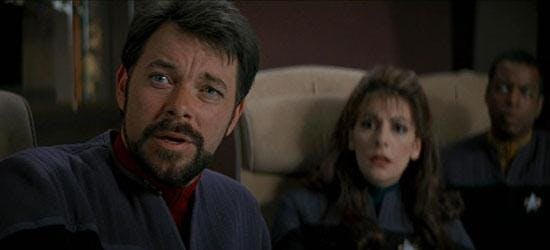
To celebrate the 20th anniversary of First Contact, we at StarTrek.com reached out to Frakes, who agreed to answer questions posed by fans via our Facebook page. And you, the fans, flooded the site with hundreds of questions. We then posed to Frakes as many as time allowed during a recent half-hour conversation. We’ve broken the resulting interview into two parts. Part one, which ran yesterday, focused on TNG (the series), Frakes’ career and his current projects. Part two, down below, centers on First Contact,’ which opened 20 years ago today. Here’s what he had to say:
TNG was not an action series. It had moments of action that popped up from time to time, but the show was never about that. The movies had a much heavier emphasis on action. As a director, was it a challenge to maintain the tone of the series while putting more focus on action?
Luckily, we had the time to do both, which we did not often get with the seven days that we had to do episodes of the show. We also had the talent and the resources, and we were able to take advantage of having John Knoll and our stunt coordinator and special effects and visual effects. And as I like to say, we got to blow a lot of sh-t up, which we couldn’t do on TV.
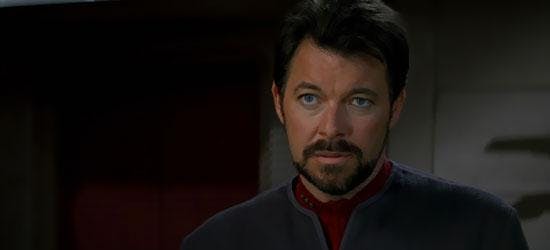
Was there ever any consideration to seeing Borg-fied Romulans or Klingons on screen in First Contact?
Not that I know of. It’s a little late, but that’s a really good idea.
The arc of Lily and Jean-Luc's relationship from distrust (Lily) and condescension (Picard) to mutual respect is one of the most profound and mature in the whole of Star Trek. Was it difficult to make that arc happen, when competing with the Borg/action/suspense and Earth/comedy plotlines?
One of the gifts of that script was that it was peppered with comedy, it was peppered with romance, it was peppered with horror and action. It’s so easy to say, but if it’s not on the page, it’s not on the screen. And when it is on the page, and it’s that dense and that varied and that well done, then it’s just a pleasure. And it certainly didn’t hurt to have Alfre Woodward and Patrick Stewart going head to head.
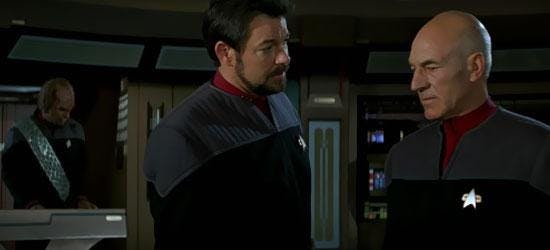
Were there any discussions in the editing bay about cutting those scenes for time or pace?
No. Everyone realized that they worked. And those scenes, I think, set up and humanized Picard in a way that was quite good for that character.
Did you occasionally feel hesitant about the possibilities of continuity paradoxes when you (initially) read the script too?
I have no idea what that means! (Laughs)
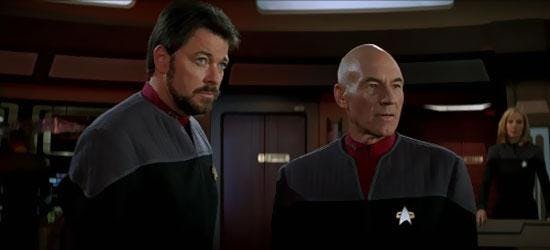
Were you worried about screwing up the timeline?
No, no, no, no (still laughing). That’s why the J.J. movies don’t bother me. I’m not a purist in terms of the Star Trek timeline. I know that’s tantamount to treason, but I kind of like a good story. I know I should care more about the timeline, but… you don’t want to get me into that trouble, do you?
Since Q was responsible for getting the Federation to meet the Borg before they were ready, why couldn't Q be in the movie?
I always wondered why Q wasn’t in the movie. Q didn’t make it into any of our movies. I always thought he was our most-potent nemesis. I pitched him, pitched John (de Lancie) for both movies that I did, and I’m not sure what happened. Rick Berman’s answer was always that the studio didn’t feel he was a substantial-enough villain, which may or not have been true. But I’m such a huge fan of Q and what he did for the series and he provided for the series. He was kind of a sounding board and a weird, offbeat moral compass. Also, de Lancie is a genius. So, I don’t really understand why.

Did you have any input in the visual effects aspects of the movie. As an example, were you offered different concept designs of the new Enterprise or offer ideas as to what you would like to see? Or was this an aspect you left in the hands of the designers?
I certainly didn’t design anything, but I commented on designs. Generally what they would do is give us two or three proof of concept art pieces, and from that Rick and I, or Rick and the writers and I, and would comment and respond to the pieces. But the designs were Herman Zimmerman’s ships and, by extension, ILM’s ships, and they looked like they were built at Starfleet. They all had that gestalt and it was just a matter of noodling with certain details. But you recognize a Starfleet ship, I think.
I loved the version of Roy Orbison's "Ooby Dooby" they had. I'm almost sure it can only be found in the movie's soundtrack. I couldn't find it in other album. And I'm curious about how they got it in the film…
We were trying desperately to get a Rolling Stones or David Bowie song that I can’t remember the name of right now, but we couldn’t afford it. It was beyond our price range. Peter Lauritson, who was the producer of all things post (-production) on the show and on the movies, and also a wonderful musicologist, found and suggested and negotiated “Ooby Dooby.” He put it in there and it was the perfect to what would have been a very expensive question if we had gone with the Stones or Bowie song.
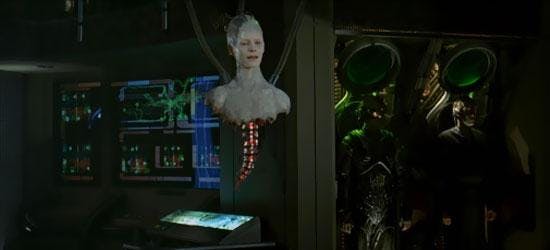
When the Borg queen says, “I am the beginning and the end. I am the One…,” this is almost a quote from Isaiah. Was it meant to be a Bible quote?
Very good question. But I don’t know the answer. That’s one for the writers.
First Contact was your feature film debut. What was it like composing shots for widescreen for the first time?
We composed shots in the same size. Anamorphic is the fancy word for the format that we all have now on our big-screen TVs. But I am happy to have been told early on, “Don’t be afraid to shoot wide.” That’s a quote from the great Sherry Lansing (then-chairman of Paramount Pictures). I still do that on TV. I always hold on to some time, even if we’re in a room, to shoot a big, wide shot, so that you can see the whole room, know where everybody is. It was an old Aaron Spelling rule, that you had to show where you were at least once. Now, I like to do it sort of off-angle and with a wider lens. Even if you do it for a couple of seconds, I think a wide shot helps everybody and makes a TV show look more filmic.
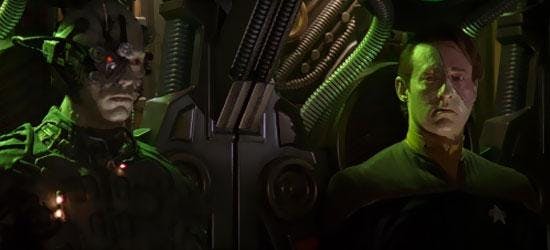
Did you know you were giving us a big money zombie flick before zombies were cool?
No, but I am very thankful. And I will take all the credit for it.
It is going around that an object which resembles the Millennium Falcon is seen in the final battle. Could you please clarify if this was intended? If it was an homage? If it's known vessel type?
Oh, my God, that’s too deep into the minutiae for me. That’s a question for the visual effects guys. I’m not aware of it.
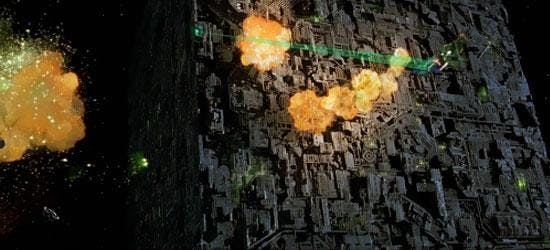
What would you like to add to First Contact that you didn’t have time to do during the original filming?
That is a good question. Hmmmm. Honestly, nothing, because, if I remember correctly, we added a couple of extra days of shooting in order to sell the Borg-ification of the ship. That, I think, answers that question. It felt like we needed those shots and we got them, so we added what we needed. I wish I had a clever answer for what I’d add now.
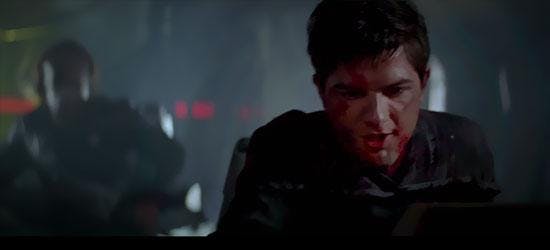
When was the last time you watched First Contact, and how different an experience was it for you to see it again recently versus back in 1996, when you were so close to the film?
Another good question. I watched it within the last year, and I was still thrilled with it. I thought some of it held up beautifully and some of it felt dated. I thought that the storytelling and the casting and the shot-making, and even many of the visual effects still hold up well. Alice Krige really sold the Borg Queen’s spinal cord connecting to her body. It was just a beautiful combination of acting and special effects. I will say that what felt a little dated was the walking on the outside of the saucer with the magnetic boots. But that scene had Neal McDonough, and he really took off in his career, didn’t he? I discovered him. And, you know who else is in First Contact? Adam Scott.
There were many variations of this question, but they boiled down to this: How crazy is that it’s 20 years since First Contact came out?
It’s very hard to believe. And it’s almost 30 years for The Next Generation. That’s coming up next. That’s the next big anniversary. I’m very grateful that I’ve been working enough to make it feel like the time has flown by. Also, it’s flown by because all of us (from TNG) hang out together and see each other. And we pretend that we’re still in our 30s (laughs) and not our 60s.
Go HERE to read part one of our interview with Jonathan Frakes, in which he answers your specific questions about his career and TNG.
